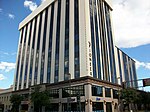Presidio San Agustín del Tucsón
1775 establishments in New SpainBuildings and structures demolished in 1918Buildings and structures in Tucson, ArizonaDemolished buildings and structures in ArizonaHistory of Tucson, Arizona ... and 2 more
Populated places in Pima County, ArizonaPresidios in Arizona

Presidio San Agustín del Tucsón was a presidio (colonial Spanish fort) located within Tucson, Arizona, United States. The original fortress was built by Spanish soldiers during the 18th century and was the founding structure of what became the city of Tucson. After the American arrival in 1846, the original walls were dismantled, with the last section torn down in 1918. A reconstruction of the northeast corner of the fort was completed in 2007 following an archaeological excavation that located the fort's northeast tower.
Excerpt from the Wikipedia article Presidio San Agustín del Tucsón (License: CC BY-SA 3.0, Authors, Images).Presidio San Agustín del Tucsón
North Court Avenue, Tucson El Presidio
Geographical coordinates (GPS) Address Nearby Places Show on map
Geographical coordinates (GPS)
| Latitude | Longitude |
|---|---|
| N 32.2245 ° | E -110.973373 ° |
Address
Tucson Presidio
North Court Avenue
85701 Tucson, El Presidio
Arizona, United States
Open on Google Maps










